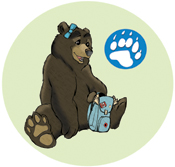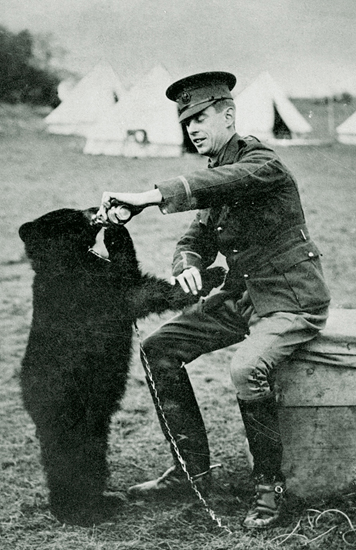Bears as Mascots?
by Win, Winnipeg, Manitoba

In 1914, just after the First World War began, Harry Colebourn of Winnipeg began his train trip to the army camp in Valcartier, Quebec. Canadian Forces Base (CFB) Valcartier is located 25 km west of Quebec City. CFB Valcartier was erected as a military camp in August of 1914 to train soldiers at the beginning of the First World War. Because of its location close to the port of Quebec, it became the largest military camp on Canadian soil, having some 32,000 men and 8,000 horses.

Photo Credit: Harry Colebourn and Winnie at Salisbury Plain in 1914. Source: Provincial Archives of Manitoba, Colebourn, D. Harry Collection, No. N10467

Photo Credit: Winnie featured in her own signed publicity shot, dated February 16, 1916. Provincial Archives of Manitoba, Colebourn D. Harry 15 Collection, No. N10473
It was a long ride to CFB Valcartier, so the train made a stop in White River, Ontario. That’s where Harry met my relative, a cute black bear cub whose mother had been killed by a trapper.
Harry bought the cub for $20 and named her “Winnie,” after—you guessed it—Winnipeg, Manitoba, his hometown. Winnie became the mascot of Harry Colebourn’s infantry brigade and sailed across the Atlantic Ocean to England with her new friends.
Soon after he arrived in England, Harry Colebourn was sent to the war in France. It wouldn’t be safe for the bear cub or the soldiers to have Winnie with the army, so Harry donated Winnie to the London Zoo. She would be cared for and the children of London would be able to enjoy seeing Winnie.
During the war, Harry Colebourn worked with the Canadian Army Veterinary Corps—more animals for Harry! And lots of children visited the London Zoo to see Winnie. One of those children was Christopher Robin Milne, whose father was a writer. After their visit, Christopher Robin named his toy teddy bear “Winnie the Pooh.” His father wrote a book about his son and his bear.
Winnie the girl-bear became Winnie the boy-bear in the story. Now, millions of children around the world know the name Winnie. I live in Winnipeg where the story began and where you can see almost-life-size statues of Harry Colebourn and Winnie in Assiniboine Park Zoo.
Big Body, Bright Brain- Date modified: